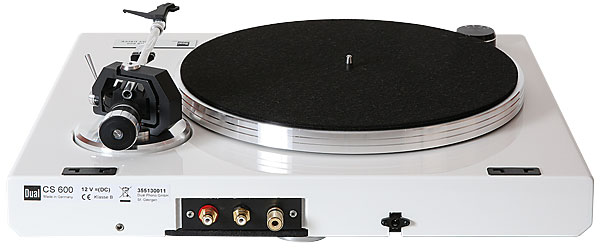Dual CS 600 Turntable

 Affordable German turntables are looking set to repeat their dominance of the market they owned 50 years ago. Can Dual's top-of-the-range CS 600 raise the stakes?
Affordable German turntables are looking set to repeat their dominance of the market they owned 50 years ago. Can Dual's top-of-the-range CS 600 raise the stakes?
A tough review for me to write, at least objectively: I'm rooting for the CS 600 to be something special because my first turntable was a Dual and I recall it with fondness. I want the CS 600 to be a champ like the all-conquering '505 was back in the days of the NAD 3020-based systems. But this new deck costs £1199 in black, or another £200 in gloss black or white (as reviewed), and the competition for turntables with tonearms is fierce around this price point.
The CS 600 sits at the top of a family of ten models, five outsourced and five made in Germany. Unlike the automatics and semi-automatics Dual was best-known for, and which comprise most of the catalogue, this and the CS 550 are manual designs that have to compete with market leaders from Rega, Pro-Ject, Thorens and a host of others, including the recently-launched affordable models from EAT.
Dual is thus re-entering a market sector that, circa-2019, not only serves well-heeled newcomers, but first-time upgraders and a host of others likely to be savvy about what constitutes a good deck.
Topical Tweaks
Within the nicely-finished wooden plinth (curiously not offered in its natural state), a DC motor belt-drives an aluminium sandwich platter, damped with copper rings and polymer. Unusually, the CS 600 offers the three speeds of 33.33, 45 and 78rpm, those of an archivist bent surely welcoming the last of the trio.

A nice touch is a pair of wires on either side of the hole that goes over the spindle, as they clip the platter to the spindle once it's dropped into place, after the flat belt has been fitted. A thick, felt mat is supplied, and the LP support it provides is nicely damped. Tweak No1 thus presents itself: a lightweight clamp or puck seems a natural addition.
Note the numerical suffix to 'tweak'. This deck begs the ownership of an enthusiast because, as seems to be an increasing trend, the CS 600 does not force captive leads on the user. Enter Tweak No2: at the rear of the plinth can be found robust RCA sockets and an earthing post for the supplied phono-to-phono-plus-earth-wire cable. This means that cable junkies are encouraged to experiment, as I did. The other socket at the back is the input for power from a wall wart.
Then we come to the deck's Achilles' heel or, more strictly, arm. Dual has developed a new tonearm, just for this deck, with easy height adjustment, conventional balancing, etc, but with what I consider to be one of the most frustrating cartridge mounting set-ups I have encountered since a certain British tonearm of the late '70s, which consisted of a crossbar on a tubular arm, and which could not easily be levelled.
Held Captive
When I opened the box and saw the clear plastic jig for setting up cartridge alignment, I was immediately reminded of the Dual 1019 that I bought back in 1968. The 1019's set-up was so clever that this then-novice was able to install a Pickering cartridge without any assistance, having never fitted one before. The cartridge platform and wires were held in place under a headshell of sorts, in a removable, self-contained module that made the connecting of the wires and the screwing in of the cartridge itself a breeze. You slipped the clear plastic jig over the cartridge/platform assembly, lined up the stylus and tightened the screws. You then returned the cartridge carrier to the headshell, and locked it into place by turning the finger lift toward the front, nice and secure and with ideal overhang and VTA. And if a klutz of a 16-year-old could do it, with nothing more than tweezers, a small screwdriver and a superb owner's manual, a half-century later the procedure should have repeated itself.
Sadly, this is not the case. With the CS 600, the headshell is removed for cartridge installation by unscrewing a collar as with SMEs, Ortofons and other detachable-headshell designs – so far, so conventional. Unfortunately, the cartridge wires are captive in the arm, not in the headshell part, and when you remove the headshell, they stay in situ. So... you have to fit the cartridge to the headshell, line it up with the jig, then feed the wires back through the hole at the rear of the headshell before re-attaching it to the arm.
Only now there is hardly any space to work (depending on the cartridge's body size and shape), so you must choose to attach the wires to the cartridge pins with either the shell refitted to the arm, and then try to manoeuvre the wires, or connect the wires before you screw the headshell back into place. Furthermore the combination of carbon fibre headshell and thread with a metal collar did not fill me with confidence about its rigidity.
























































